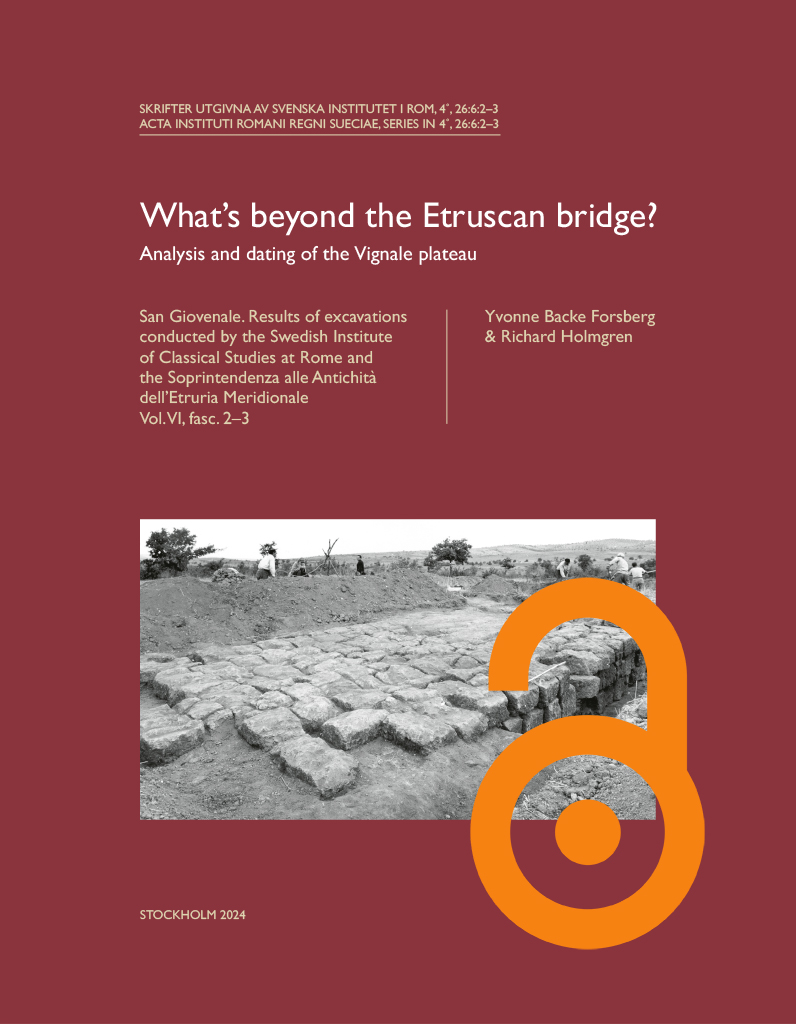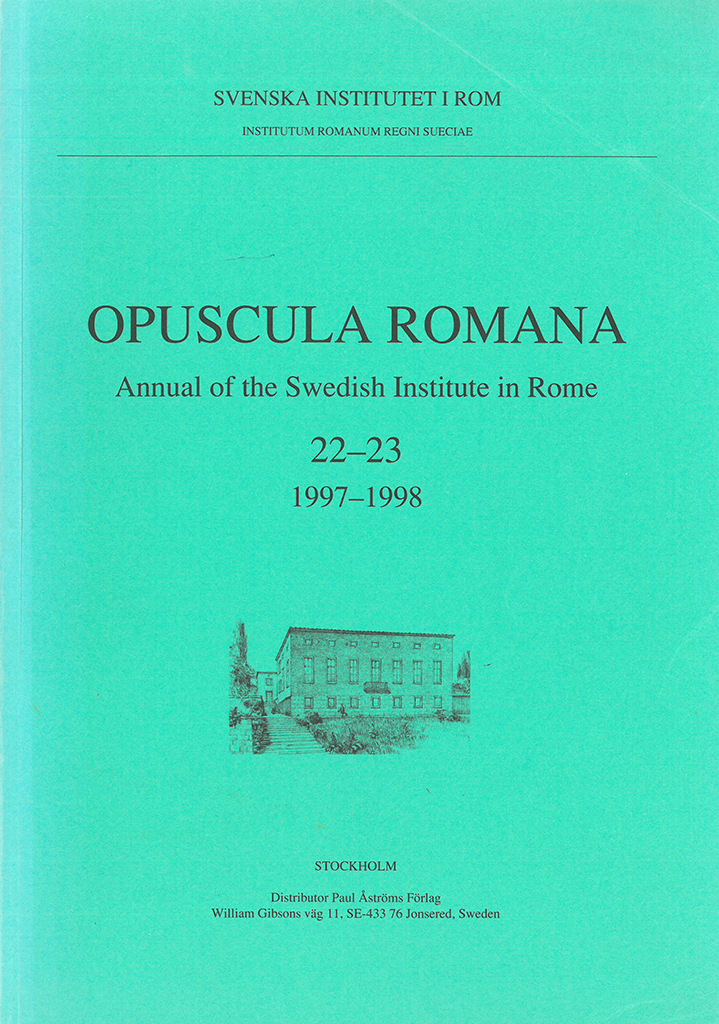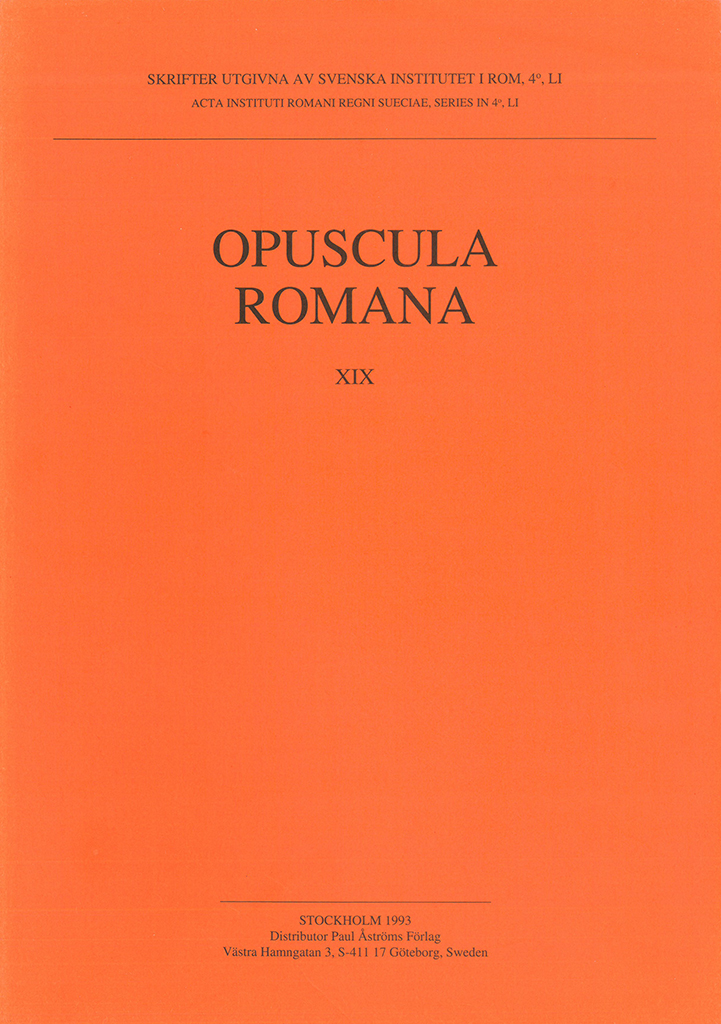San Giovenale vol. 6, fasc. 2–3. What’s beyond the Etruscan bridge? Analysis and dating of the Vignale plateau By Yvonne Backe Forsberg & Richard Holmgren. Stockholm 2024. ISBN: 978-91-7042-188-4 (hardcover: 345 pp.). https://doi.org/10.30549/actarom-4-26-6-2-3 For more information about the San Giovenale-series, see https://ecsi.se/actarom-4-26/ Published by the Swedish Institute of Classical Studies in Rome. Distributed by Eddy.se AB. Open access, use links below. The Etruscan site of San Giovenale has been excavated periodically since 1956. From the beginning the main focus has been the question of settlement remains. However, a fundamental area within the site had still not undergone the inquiry necessary for a complete understanding of the site as a whole. The Vignale plateau, connected to the main site by an Etruscan bridge, was surveyed and partly excavated in 1959–1960, but not published. The Vignale Archaeological Project (VAP) began new investigations in 2006 that aimed to answer the question of “What’s beyond the Etruscan bridge?” This publication focuses on the initial investigations of 1959–1960, augmented by new ground- and aerial remote sensing surveys. The current volume is divided in six chapters. Through an introduction, and geological/topographic and historical/archaeological settings (Chapters 1–3), the reader achieves a general understanding of Vignale within a…
All content of Opuscula 13 is available with open access. Printed edition distributed by Eddy.se AB. Also available at Amazon.com, Adlibris, and Bokus. View volume at ERIH PLUS. Erik Wetter and the genesis of the San Giovenale excavations By Fredrik Tobin-Dodd (Swedish Institute of Classical Studies in Rome, Italy) Abstract The Swedish excavations at San Giovenale (1956–1965) had a major impact in the field of pre-Roman archaeology in Italy, primarily through the discovery of remains of both Etruscan and earlier domestic architecture. This article examines the genesis of the project, and suggests that the early history of the project has sometimes been misrepresented. While the excavations came to serve as a training-ground for young Swedish archaeologists and made very important contributions to the study of ancient domestic architecture, these were not explicit goals at the conception of the project. The article also studies the peculiar role of Admiral Erik Wetter in the San Giovenale excavations. Despite not being an archaeologist himself, Wetter was both the instigator and, in many ways, the driving force behind the project. The result was an unusual and unclear leadership situation, something that in the long run created problems for the project. Bibliographical information Fredrik Tobin-Dodd,…
Opuscula 2 (2009) is now available for purchase and free download at Bokorder.se. Also available at Amazon.com, Amazon.de, Bokus.com and Adlibris.com. The Brygos painter at San Giovenale By Yvonne Backe-Forsberg Abstract Based on stylistic criteria, it is argued in the following article that two Attic red-figured cups, one fragmentary kylix called the Pietrisco cup found in the Etruscan Bridge complex and the other one from a chamber tomb at San Giovenale, were made by the Brygos painter or a member of his circle c. 490–480 BC. The Pietrisco cup may even have been produced by Brygos the potter as it belongs to the cone-foot class. This group was previously dated to 480–475 BC, but is now backdated to 490–475 due to the analysis of the painting on the tondo of the Pietrisco cup. The Pietrisco cup was found with a substantial amount of Attic Black-figured, Red-figured and Blackglazed fragments in a fill deposit in a quadrant building of tufa ashlars interpreted as a sacellum near the Etruscan bridge at the Pietrisco brook in San Giovenale, Etruria. The two cups are the third and fourth kylikes attributed to the Brygos painter found in the settlement and in tombs at San Giovenale…
Now available for purchase at Amazon.com, Amazon.de, Bokus.com, Adlibris.com, and Bokorder.se. Contents Johnny R. Bengtsson | Late Bronze Age handles from the Apennine settlement at Luni sul Mignone: Some chronological observations Ingela M.B. Wiman & Yvonne Backe-Forsberg | Surfacing deities in later Etruscan art and the sacellum at San Giovenale Allan Klynne | The Villa Selvasecca revisited John W. Hayes | Villa Selvasecca: the pottery finds Ebba Engström & Ragnar Hedlund | Villa Selvasecca: the coins Dominic Ingemark | Villa Selvasecca: the glass Anne-Marie Leander Touati | Interim report of the Swedish Pompeii Project: Work 2000–2004/5 in Insula V 1. Introduction Margareta Staub Gierow | The House of the Greek Epigrams V 1,18.11–12: preliminary report 2000–2004 Arja Karivieri & Renée Forsell | The House of Caecilius Iucundus, V 1,22–27: a preliminary report Henrik Boman & Monica Nilsson | The commercial establishments V 1,13; V 1, 14–16; V 1,20–21: preliminary report 2001–2004 Mark Robinson | Evidence for garden cultivation and the use of bedding-out plants in the peristyle garden of the House of the Greek Epigrams (V 1, 18i) at Pompeii Henrik Boman & Monica Nilsson | The early street and the prehistoric finds in Vicolo delle Nozze d’Argento, Pompeii Jörg…
Distributed by Astrom editions. See record at WorldCat. Contents Anne-Marie Leander Touati | The Piranesi marbles from Rome to Stockholm. An introduction to research in progress (pp. 7–29) Raffaela Bosso | Osservazioni sull’attività della bottega Piranesi tra Giovanni Battista e Frencesco: il caso esemplare del gruppo di candelabri con trampolieri (pp. 31–62) Dietrich Boschung & Glenys Davies | Arae Passieniorum (pp. 63–72) G.F. Guidi, C. Giardino & G. Trojsi | L’insediamento etrusco di San Giovenale (Blera, Vitterbo). Caratterizzazione chimico-fisica dei residui delle attività produttive (pp. 73–84) Kristina Jonsson | Intra mural graves in Rome. Social dimensions in early medieval burial practices (pp. 85–95) Monica Nilsson & Mark Robinson | Remains of prehistoric habitation beneath Pompeii V 1,13 (pp. 97–103) Bengt E. Thomasson | Laterculi praesidium. Addendorum series quarta (pp. 105–122) Book reviews Örjan Wikander | L. Ambrosini, Thymiateria etruschi in bronzo di età tardo classica, alto e medio ellenistica (pp. 123–131) Izabella Donkow | B. Burell, Neokoroi: Greek cities and Roman emperors (pp. 132–133) Bibliographical information Opuscula Romana. Annual of the Swedish Institute in Rome (OpRom) 30, Stockholm 2006. ISSN: 0471-7309. ISBN: 91-7042-173-0. Softcover, 133 pages. Reviews L’Antiquité Classique (Jean-Charles Balty)
Distributed by Astrom Editions. Contents Gabriella Barbieri | Materiali etrusco-romani da Viterbo. Corredi funerary inediti dalla località San Nicolao Giovanni Colonna & Yvonne Backe Forsberg | Le iscrizioni del ‘sacello’ del ponte di San Giovenale / Etruscan inscriptions and graffiti from the bridge at San Giovenale Francesco Galluccio | Volterra etrusca alla luce delle nuove scoperte Lars Karlsson | Excavations at San Giovenale in 1999. Fortifications on the Borgo Peter Liljenstolpe | Superimposed orders. The Use of architectural orders in multi-storeyed structures of the Roman Imperial era Ida Östenberg | Demonstrating the conquest of the world. The procession of peoples and rivers on the shield of Aeneas and the triple triumph of Octavian in 29 B.C. (Aen. 8.722–728) Bengt E. Thomasson | Laterculi praesidum. Addendorum series tertia Books received Bibliographical information Opuscula Romana. Annual of the Swedish Institute in Rome (OpRom) 24, Stockholm 1999. ISSN: 0471-7309. ISBN: 978-91-7042-162-4. Softcover, 174 pages.
Distributed by Astrom Editions. Contents Olof Brandt | Il battistero lateranense da Constantino a Ilaro. Un riesame degli scavi (pp. 7–65) Daniel Fuglesang | Two unpublished chamber tombs from San Giovenale (pp. 67–89) Peter Liljenstolpe | The Roman Blattkelch capital. Typology, origin and aspects of employment (pp. 91–126) Peter Liljenstolpe & Allan Klynne | The imperial gardens of the Villa of Livia at Prima Porta. A preliminary report on the 1997 campaign (pp. 127–147) Manlio Lilli | Un ambiente termale lungo la via Calmazzo—Urvinum Mataurense, presso il vicus di Canavaccio (PS) (pp. 149–155) The Swedish Institute in Rome. Report for the academic years 1996–1997 and 1997–1998 (pp. 157–160) Bibliographical information Opuscula Romana. Annual of the Swedish Institute in Rome (OpRom) 22–23, Stockholm 1998. ISSN: 0471-7309. Softcover, 160 pages.
Published by the Swedish Institute of Classical Studies in Rome. Distributed by Astrom Editions. Opuscula Romana 20. Pär Göran Gierow dedicata Contents Kristina Berggren, Tre tombe a cremazione con trace di legno nella necropolis di Quattro Fontanili a Veio (Roma) Ingrid E.M. Edlund-Berry, The power of cults and sacred spaces. The interpretation romana of sanctuaries in southern Italy and Sicily Maria C. Eriksson, Two Etruscan mirrors in the Thorwaldsen Museum, Copenhagen Björn Forsén & Timo Sironen, Bolli laterizi romani nell’Antikmuseet in Göteborg Lena Landgren, The Roman pleasure garden—foundations for future studies Peter Liljenstolpe, De ornamentis templi Urbis. Reconstructing the main order of the temple of Venus and Roma in Rome Alessandro Naso, Osservazioni sull’origine dei tumuli monumentali nell’Italia centrale David Ridgway, Greek letters at Osteria dell’Osa Paavo Roos, Strabo and the water-mill at Cabeira. Some considerations Raffaele Santillo, Il «saxum ingentem» a Ravenna a copertura del Mausoleo di Teoderico: problemi e soluzioni Martin Söderlind, A central Italic, terracotta votive head in the Classical Museum of Antiquities in Lund (in association with Pierluigi Bianchetti, technical analysis) Margareta Strandberg Olofsson, Pottery from the monumental area at Acquarossa: a preliminary report Bengt E. Thomasson, Laterculi praesidium. Addendorum series altera Örjan Wikander, Senators and…
Published by the Swedish Institute of Classical Studies in Rome. Distributed by Astrom Editions. Opuscula Romana 19 Contents Carl Nylander, Gustavo VI Adolfo, il “re archeologo” S.M. Il Re Gustavo VI Adolfo, Discorso in occasione del conferimento della laurea ad honorem Oxford 1955 Olle Brandt, Recent research on the tomb of Eurysaces Peter Danner, Stützen im Giebel—Ein Motiv der etruskischen Wandmalerei Harry Erkell, L’Imperatore Commodo ed Ercole-Melcart Pamela Hemphill, The Romans and the San Giovenale area Bo Lawergren, Lyres in the West (Italy, Greece) and East (Egypt, the Near East), ca. 2000 to 400 B.C. Örjan Wikander, Senators and equites V. Ancestral pride and genealogical studies in Late Republican Rome Charlotte Wikander, Acquarossa: campagna di scavo 1991 The Swedish Institute in Rome. Report for the academic years 1990–91 and 1991–92 Book reviews Charlotte Wikander, review of R.R. Knoop, Antefixa Satricana. Sixth-century architectural terracottas from the sanctuary of Mater Matuta at Satricum (Le Ferriere) Örjan Wikander, review of O. Salomies, Die römischen Vornamen. Studien zur römischen Namengebung Örjan Wikander, review of I. Nielsen, Thermae et balnea. The architecture and cultural history of Roman public baths Örjan Wikander, review of G. Brodribb, Roman brick and tile Göran Bäärnhielm, review of B. Mattson,…
Stig Forsberg & Bengt Erik Thomasson, eds, 1984. San Giovenale. Materiali e problemi. Atti del simposio all’Instituto Svedese di Studi Classici a Roma 6 Aprile 1983, Stockholm (softcover: 108 pp.). ISBN 9789170420986 Published by the Swedish Institute of Classical Studies in Rome. Distributed by Astrom Editions.









